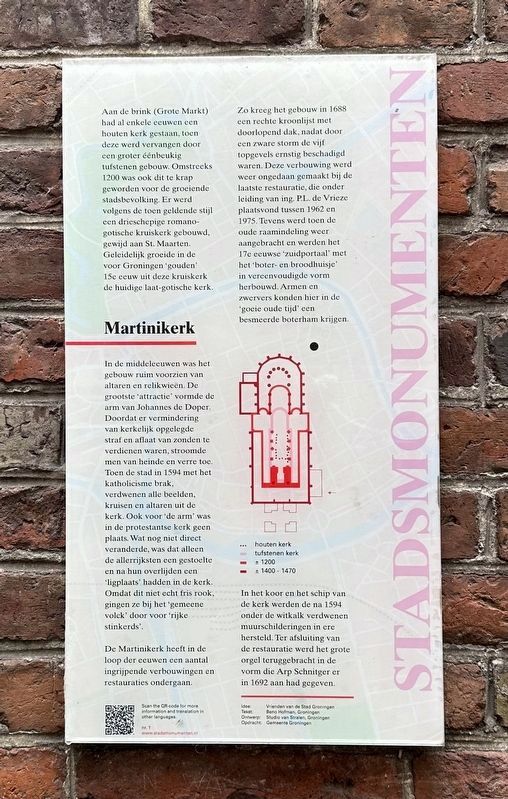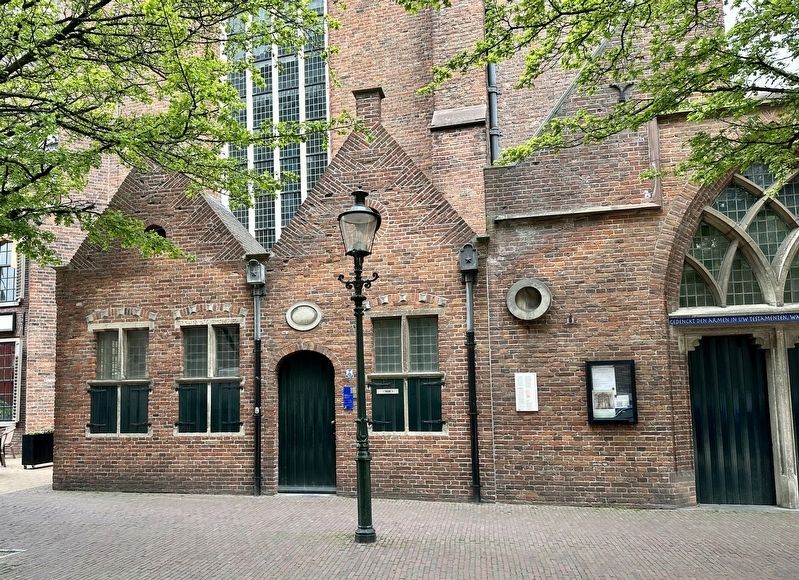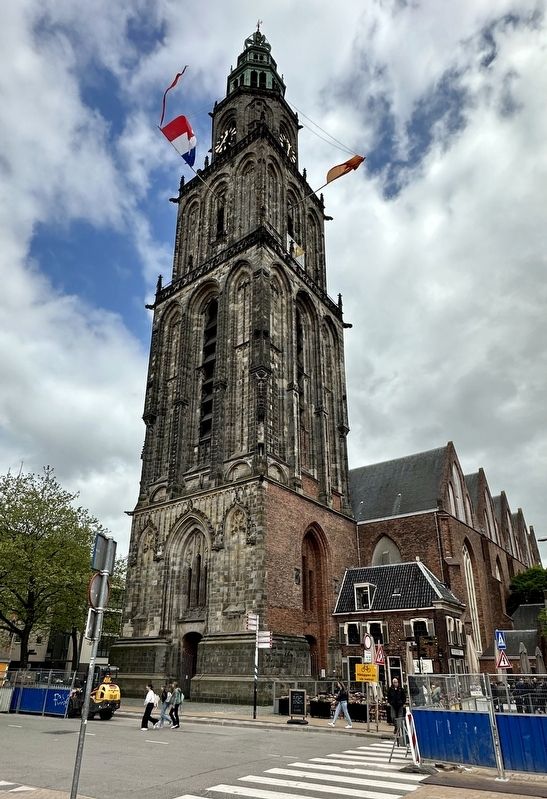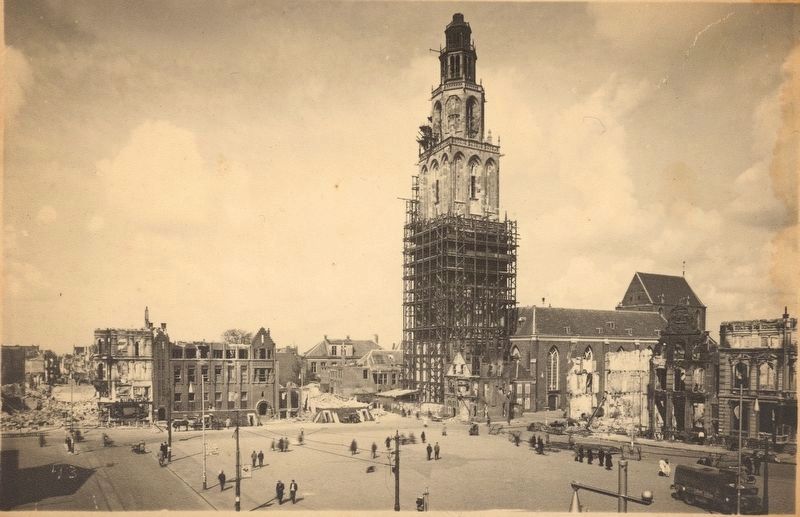Groningen, Netherlands — Northwestern Europe
Martinikerk / St. Martin Church
— Stadsmonumenten —
Aan de brink (Grote Markt) had al enkele eeuwen een houten kerk gestaan, toen deze werd vervangen door een groter éénbeukig tufstenen gebouw. Omstreeks 1200 was ook dit te krap geworden voor de groeiende stadsbevolking. Er werd volgens de toen geldende stijl een drieschepige romano-gotische kruiskerk gebouwd, gewijd aan St. Maarten. Geleidelijk groeide in de voor Groningen ‘gouden’ 15e eeuw uit deze kruiskerk de huidige laatgotische kerk.
In de middeleeuwen was het gebouw ruim voorzien van altaren en relikwieën. De grootste ‘attractie’ vormde de arm van Johannes de Doper. Doordat er vermindering van kerkelijk opgelegde straf en aflaat van zonden te verdienen waren, stroomde men van heinde en verre toe. Toen de stad in 1594 met het katholicisme brak, verdwenen alle beelden, kruisen en altaren uit de kerk. Ook voor ‘de arm’ was in de protestantse kerk geen plaats. Wat nog niet direct veranderde, was dat alleen de allerrijksten een gestoelte en na hun overlijden een ‘ligplaats’ hadden in de kerk. Omdat dit niet echt fris rook, gingen ze bij het ‘gemeene volck’ door voor ‘rijke stinkerds’.
De Martinikerk heeft in de loop der eeuwen een aantal ingrijpende verbouwingen en restauraties ondergaan. Zo kreeg het gebouw in 1688 een rechte kroonlijst met doorlopend dak, nadat door een zware storm de vijf topgevels ernstig beschadigd waren. Deze verbouwing werd weer ongedaan gemaakt bij de laatste restauratie, die onder leiding van ing. P.L. de Vrieze plaatsvond tussen 1962 en 1975. Tevens werd toen de oude raamindeling weer aangebracht en werd het 17e eeuwse ‘zuidportaal’ met het ‘boter- en broodhuisje’ in vereenvoudigde vorm herbouwd. Armen en zwervers konden hier in de ‘goeie oude tijd’ een besmeerde boterham krijgen.
In het koor en het schip van de kerk werden de na 1594 onder de witkalk verdwenen muurschilderingen in ere hersteld. Ter afsluiting van de restauratie werd het grote orgel teruggebracht in de vorm die Arp Schnitger er in 1692 aan had gegeven.
On the village square, stood a large wooded church for several centuries. Later, it was replaced by an even larger single-aisled tufa stone building/church. The urban population kept growing, and therefore the church also became too small. A new building was built, according to the then applicable style, with three naves Romano-gothic cruciform, dedicated to St. Maarten. In Groningen’s ‘Golden Age’ the church transformed from the city’s
cross church to its current late-gothic church.
In the middle ages, the church was decorated with altars and relics. The biggest tourist attraction was ‘the arm of John the Baptist’. Because of the reduction of church imposed punishment and the possibility to buy indulgence for one’s sins, people visited from near and far away. In 1594, the city broke with Catholicism and all pictures, crosses and altars were removed from the church. The Protestant Church also did not have room anymore for ‘the arm’. However, the church did not change its policy on only burying the very rich citizens of the city. As this smelt badly, “the common people” called them the ‘rich stinkers’.
The Martini Church has seen a substantial amount of renovations and restorations over the past centuries. In 1688, the building’s roof was renovated with a straight cornice with a continuous roof after a heavy storm destroyed the five gables. The renovated was made undone at a later restoration, led by P.I. Davies between 1962 and 1975. In this time, the old window format was also rebuilt and the 17th century south portal with the ‘butter and bread home’ was rebuilt in a simplified form. Back in the day, homeless villagers could come to the church to get a free buttered slice of bread.
The whitewash murals that hid the choir and the nave of the church in 1594 were also restored. Finally, in honour of the restoration being finished, the great organ was brought back in the format that it had been envisioned by Arp Schnitger in 1692.
Erected by Gemeente Groningen. (Marker Number 001.)
Topics and series. This historical marker is listed in this topic list: Churches & Religion. In addition, it is included in the Groningen Stadsmonumenten series list. A significant historical year for this entry is 1200.
Location. 53° 13.156′ N, 6° 34.118′ E. Marker is in Groningen. Marker is on Martinikerkhof, on the left when traveling east. Touch for map. Marker is at or near this postal address: Martinikerkhof 2, Groningen 9712 JG, Netherlands. Touch for directions.
Other nearby markers. At least 8 other markers are within walking distance of this marker. Martinitoren / St. Martin Tower (a few steps from this marker); Feithhuis (within shouting distance of this marker); Provinciehuis / Provincial House (about 90 meters away, measured in a direct line); De Drie Gezusters / The Three Sisters (about 120 meters away); De bevrijding van Groningen / The Liberation of Groningen Memorial (about 120 meters away); Groningen Municipal Council Members Memorial (about 150 meters away); St. Walburgstraat 1 (about 150 meters away); Prinsenhof (about 150 meters away). Touch for a list and map of all markers in Groningen.
Also see . . . Martinikerk (Groningen).
Overview: The Martinikerk (Martin's church) is the oldest church in Groningen, Netherlands. The church and its associated tower (the Martinitoren) are named after Saint Martin of Tours (316–397), the patron saint of the Bishopric of Utrecht to which Groningen belonged.(Submitted on July 29, 2023.)
The church was a cathedral for a short period during the first bishopric of Groningen (1559–1594).
Credits. This page was last revised on July 29, 2023. It was originally submitted on July 29, 2023, by Andrew Ruppenstein of Lamorinda, California. This page has been viewed 44 times since then and 10 times this year. Photos: 1, 2, 3, 4. submitted on July 29, 2023, by Andrew Ruppenstein of Lamorinda, California.



